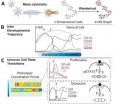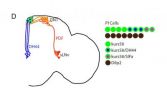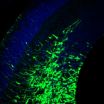(Press-News.org) 1. Measles outbreaks prompt concern about physician knowledge gaps
Vaccination refusal and importation of the disease has led to increased incidence of measles in the United States. Before widespread vaccination, approximately 500,000 measles cases occurred annually, resulting in 500 deaths and 48,000 hospitalizations. Vaccination programs helped to eradicate endemic measles by the year 2000, reducing the median number of cases per year to 60. But in just the first three months of 2014, 106 measles cases were reported, prompting health officials to become concerned. Measles is one of the most contagious infectious diseases known. Most postelimination measles cases have been due to outbreaks that can be linked imported disease. The author of a new commentary being published in Annals of Internal Medicine says many clinicians have never seen measles and now need to become familiar with the deadly disease so that they can apply the necessary control measures to contain it. Physicians should maintain a high level of suspicion for measles in returned travelers with a fever accompanied by rash. This is especially important because measles rash may be confused with other viral rashes, Kawasaki disease, or scarlet fever. The author suggests that physicians talk to their patients about the importance of measles vaccination and be vigilant about recognizing infection and implementing control measures to prevent further spread in health care facilities.
INFORMATION:
Note: The URL will go live at 1:00 p.m. on Thursday, April 24 and can be included in news stories. For an embargoed PDF, please contact Megan Hanks or Angela Collom. To interview the lead author at the Children's Hospital of Philadelphia, please contact Dana Weidig at weidigd@email.chop.edu or 267-426-6092.
Measles commentary in Annals of Internal Medicine
Tip sheet from Annals of Internal Medicine, April 24, 2014
2014-04-24
ELSE PRESS RELEASES FROM THIS DATE:
Plants send out signals attracting harmful bacteria, MU study finds
2014-04-24
COLUMBIA, Mo. – When bacteria attack plants, they often inject harmful proteins into the host plants' cells to weaken and suppress natural defenses. However, in some plants, bacteria attack once they've recognized the plant cells as a potential host. Now, researchers at the University of Missouri have identified and replicated the process that allows the bacteria—known mostly for attacking tomatoes—to invade its host. This discovery could lead to natural anti-infective treatments that work with food-producing plants to enhance resistance to harmful bacteria in the field.
"When ...
Genome yields insights into golden eagle vision, smell
2014-04-24
WEST LAFAYETTE, Ind. - Purdue and West Virginia University researchers are the first to sequence the genome of the golden eagle, providing a bird's-eye view of eagle features that could lead to more effective conservation strategies.
Their study calls into question long-held assumptions about golden eagle vision, indicating that the raptors may not be as sensitive to ultraviolet light as previously thought. The genome also suggests that golden eagles could have a sharper sense of smell than researchers realized.
Additionally, the genome provides thousands of genetic ...
International collaboration unravels novel mechanism for neurological disorder
2014-04-24
HOUSTON – (April 24, 2014) – A team of international scientists led by Baylor College of Medicine has discovered a novel gene (CLP1) associated with a neurological disorder affecting both the peripheral and central nervous systems. Together with scientists in Vienna they show that disturbance of a very basic biological process, tRNA biogenesis, can result in cell death of neural progenitor cells. This leads to abnormal brain development and a small head circumference as well as dysfunction of peripheral nerves.
The study published today in the current issue of the journal ...
Researchers create comprehensive map of human B cell development
2014-04-24
New York, NY - In the April 24, 2014 edition of Cell, a team of researchers led by Dana Pe'er at Columbia University and Garry Nolan at Stanford University describes a powerful new method for mapping cellular development at the single cell level. By combining emerging technologies for studying single cells with a new, advanced computational algorithm, they have created the most comprehensive map ever made of human B cell development. Their approach will greatly improve researchers' ability to investigate development in cells of all types, make it possible to identify rare ...
Surprising new insights into the PTEN tumor suppressor gene
2014-04-24
BOSTON – Ever since it was first identified more than 15 years ago, the PTEN gene has been known to play an integral role in preventing the onset and progression of numerous cancers. Consequently, when PTEN is either lost or mutated, malignant cells can grow unchecked and cancer can develop.
Now a team led by investigators at Beth Israel Deaconess Medical Center (BIDMC) helps explain more precisely how PTEN exerts its anti-cancer effects and how its loss or alteration can set cells on a cancerous course. The new study, which reveals that PTEN loss and PTEN mutations are ...
Researchers pinpoint protein crucial for development of biological rhythms in mice
2014-04-24
Johns Hopkins researchers report that they have identified a protein essential to the formation of the tiny brain region in mice that coordinates sleep-wake cycles and other so-called circadian rhythms.
By disabling the gene for that key protein in test animals, the scientists were able to home in on the mechanism by which that brain region, known as the suprachiasmatic nucleus or SCN, becomes the body's master clock while the embryo is developing.
The results of their experiments, reported online April 24 in Cell Reports, are an important step toward understanding ...
Oldest pterodactyloid species discovered, named by international team of researchers
2014-04-24
WASHINGTON—An international research team, including a George Washington University (GW) professor, has discovered and named the earliest and most primitive pterodactyloid—a group of flying reptiles that would go on to become the largest known flying creatures to have ever existed—and established they flew above the earth some 163 million years ago, longer than previously known.
Working from a fossil discovered in northwest China, the project—led by University of South Florida (USF) paleontologist Brian Andres, James Clark of the GW Columbian College of Arts and Sciences ...
Fruit fly study identifies brain circuit that drives daily cycles of rest, activity
2014-04-24
PHILADELPHIA - Amita Sehgal, PhD, a professor of Neuroscience at the Perelman School of Medicine, University of Pennsylvania, describes in Cell a circuit in the brain of fruit flies that controls their daily, rhythmic behavior of rest and activity. The new study also found that the fly version of the human brain protein known as corticotrophin releasing factor (CRF) is a major coordinating molecule in this circuit. Fly CRF, called DH44, is required for rest/activity cycles and is produced in cells that receive input from the clock cells in the fly brain. In mammals, CRF ...
Scientists find way to target cells resistant to chemo
2014-04-24
Scientists from The University of Manchester have identified a way to sensitise cancer cells to chemotherapy - making them more open to treatment.
The study published today in Cell Reports, could pave the way for the development of drugs to target cells that have become resistant to treatment.
The research team made the discovery whilst exploring the possible mechanisms behind resistance to chemotherapy drugs like Paclitaxel, often used to treat breast and colon cancer.
Dr Andrew Gilmore, who led the research team at The University of Manchester, is part of both the ...
New type of protein action found to regulate development
2014-04-24
Johns Hopkins researchers report they have figured out how the aptly named protein Botch blocks the signaling protein called Notch, which helps regulate development. In a report on the discovery, to appear online April 24 in the journal Cell Reports, the scientists say they expect the work to lead to a better understanding of how a single protein, Notch, directs actions needed for the healthy development of organs as diverse as brains and kidneys.
The Johns Hopkins team says their experiments show that Botch uses a never-before-seen mechanism, replacing one chemical group ...
LAST 30 PRESS RELEASES:
NTP-enhanced lattice oxygen activation in Ce-Co catalysts for low-temperature soot combustion
Synergistic interface engineering in Cu-Zn-Ce catalysts for efficient CO2 hydrogenation to methanol
COVID-19 leaves a lasting mark on the human brain
Scientists use ultrasound to soften and treat cancer tumors without damaging healthy tissue
Community swimming program for Black youth boosts skills, sense of belonging, study finds
Specific depressive symptoms in midlife linked to increased dementia risk
An ‘illuminating’ design sheds light on cholesterol
Who is more likely to get long COVID?
Study showcases resilience and rapid growth of “living rocks”
Naval Research Lab diver earns Office of Naval Research 2025 Sailor of the Year
New Mayo-led study establishes practical definition for rapidly progressive dementia
Fossil fuel industry’s “climate false solutions” reinforce its power and aggravate environmental injustice
Researchers reveal bias in a widely used measure of algorithm performance
Alcohol causes cancer. A study from IOCB Prague confirms damage to DNA and shows how cells defend against it
Hidden viruses in wastewater treatment may shape public health risks, study finds
Unlock the power of nature: how biomass can transform climate mitigation
Biochar reshapes hidden soil microbes that capture carbon dioxide in farmland
Reducing saturated fat intake shows mortality benefit, but only in high-risk individuals
Manta rays create mobile ecosystems, study finds
Study: Mixed results in using lipoic acid to treat progressive multiple sclerosis
Norbert Holtkamp appointed director of Fermi National Accelerator Laboratory
New agentic AI platform accelerates advanced optics design
Biologists discover neurons use physical signals — not electricity — to stabilize communication
Researchers discover that a hormone can access the brain by hitchhiking
University of Oklahoma researcher awarded funding to pursue AI-powered material design
Exploring how the visual system recovers following injury
Support for parents with infants at pediatric check-ups leads to better reading and math skills in elementary school
Kids’ behavioral health is a growing share of family health costs
Day & night: Cancer disrupts the brain’s natural rhythm
COVID-19 vaccination significantly reduces risk to pregnant women and baby
[Press-News.org] Measles commentary in Annals of Internal MedicineTip sheet from Annals of Internal Medicine, April 24, 2014






